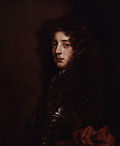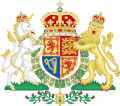History
In 1385 Richard, Earl of Arundel, was appointed Admiral of England, reuniting the offices of Admiral of the North and Admiral of the West, separate from 1294. From 1388 the offices of Admiral of the North and of the West were again distinct, though often held by the same man, until "Admirals of England" were appointed continuously from 1406. [3] The titles "High Admiral" and "Lord Admiral" were both used, eventually combining in "Lord High Admiral". The Lord High Admiral did not originally have command at sea, but had jurisdiction over maritime affairs and the authority to establish courts of Admiralty. [4]
During the reign of Henry VIII (1509–47) the English Navy had expanded to a point where it could not be managed by a single Lord High Admiral alone, therefore day-to-day management of the navy was handed over to a committee that later became known as the Navy Board. The navy board had Samuel Pepys as one of its members during the reign of Charles II (1660–85), and it ran side-by-side with the Board of Admiralty. [4]
From the early 17th century onwards, when an individual Lord High Admiral was appointed, there was also a Council of the Lord High Admiral which assisted him to perform some of the duties of the Admiralty. When this office was not occupied by an individual, it was "put into commission" and exercised by a Board of Admiralty headed by a First Lord of the Admiralty; this was the usual arrangement from 1709 until it was merged with the Admiralty in 1832. [4]
However, the office of Lord High Admiral, which—except for brief periods during its long history—had remained extant, was not abolished as an official naval post until 1964. [4] In 1964, the office of First Lord of the Admiralty was also abolished and the functions of the Lords Commissioners of Admiralty were transferred to the new Admiralty Board becoming a sub-committee (Navy) of the tri-service Defence Council of the United Kingdom. The ancient title of Lord High Admiral was resumed, by the sovereign personally. [4]
Elizabeth II held the title for the next 47 years, until in 2011 she conferred the office upon her husband, Prince Philip, Duke of Edinburgh, to celebrate his 90th birthday. [5] Philip had served in the Royal Navy during the Second World War, but he gave up a promising naval career to support Elizabeth as her consort. [6]
Current status
Upon Prince Philip's death in 2021, the identity of the holder of the office became obscure, i.e., there has been no official announcement about the office's holder since then. It is unknown whether the office of Lord High Admiral reverted to the Crown, or if it is currently vacant, in which case it remains as such until His Majesty either assumes it, or grants it upon someone else. The Ministry of Defence had confirmed they did not hold information on the issue, but suggested it had been resumed by Queen Elizabeth II in right of the Crown. [7] Upon Queen Elizabeth II's death in 2022, the office was reported to have been passed to King Charles III. [8] The office is understood to be held by the Monarch (currently King Charles III) by default and can be granted to whoever is chosen by the Monarch. [2]
This page is based on this
Wikipedia article Text is available under the
CC BY-SA 4.0 license; additional terms may apply.
Images, videos and audio are available under their respective licenses.




















